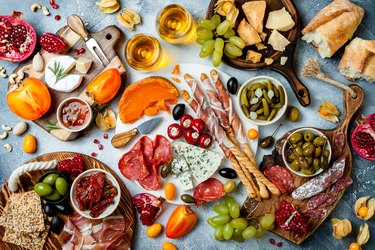
Wondering what to put on a charcuterie board? Whether you're entertaining a crowd or just settling in for a quiet movie night at home, you can't go wrong with charcuterie. It's the perfect DIY appetizer (or even light meal) for festive gatherings and casual events alike. The more people you're serving, though, the more elements your board should have and the more important it becomes to create flavor balance. Sound overwhelming? Relax, we've got you covered! Here's how to build a charcuterie board that will impress even the most discerning diner.
Charcuterie 101: What Does "Charcuterie" Mean Anyway?
Interestingly enough, the term charcuterie comes from the French “chair cuit,” meaning “cooked flesh."
Video of the Day
Part 1: Charcuterie Board Basics
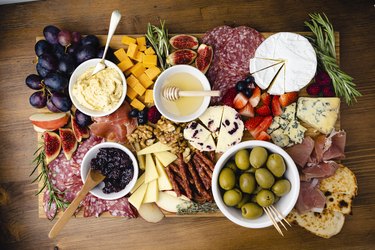
Before you scour the internet for charcuterie board ideas, it's helpful to understand the elements you'll be working with first. These break down into a handful of categories:
Video of the Day
1. The board
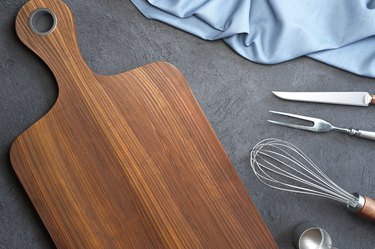
The "board" part of a charcuterie board doesn't necessarily have to be a board (options include wood, slate, bamboo and even agate), but you will need something to display your selections. If you don't have a designated cheese or charcuterie board for serving, a wood cutting board will do just fine. So will a plain old serving tray, for that matter. If you don't have a single piece of serving ware that's big enough for your spread, don't fret. It's equally effective to divide your offerings between two or three smaller platters or boards, then cluster side plates or small bowls around them to hold condiments, breads and other accompaniments. If you spread them along your table or even place them in different areas of the room, you can reduce traffic flow and overcrowding during your next gathering.
2. The meats (i.e., the actual charcuterie)

Meats are the centerpiece of any charcuterie board. They're usually cured, smoked, fermented or dried in some way. But cold cooked meats are also appropriate. You can include many types of meat on your board, including:
Hams: Italian prosciutto is the best-known example, but other dry-cured hams including Spanish jamon Iberico, Bayonne hams from France, Chinese Jinhua hams and even American "country" hams are all made in similar ways. They're sliced paper-thin for use on a charcuterie platter. Conventional wet-cured ham can go on your platter as well, either thinly sliced or in small cubes meant for eating with toothpicks. These can vary widely in quality, from generic and pedestrian to startlingly good, so try to pick one that will stand out.
Sausages: Dry-cured salami ferments as it ages, giving it remarkable depth of flavor. You'll find varieties in many styles made in many countries: There's a big difference between a garlic-forward Italian salami and an austere French "saucisson sec," seasoned solely with salt and pepper. You might opt to use many other fresh and dried sausages, from Spanish chorizo to tongue-tingling pepperoni to that really good summer sausage from your local farmers market. (Don't sleep on your local artisanal producers, some of whom make really outstanding products.)

Pâtés, rillettes and their kin: Pâtés and similar dishes are made of finely ground meats that are seasoned and then cooked very gently to preserve their delicate texture. Some hold together well enough to be put out in slices, but you'll serve others as a slab or from their container so people can serve themselves with a spreader. They tend to be quite rich.
Fish, poultry and other offerings: Most of the cured meats to choose from are pork-based, with a few beef-based options like bresaola. Those aren't your only options, though. You may find cured venison, goat or lamb in specialty stores, or turkey- and chicken-based versions of popular sausages that would normally be made from pork. Slices of cured turkey or duck breast make a nice alternative (or complement) to ham, and cold-smoked salmon or other smoked fish preparations can also add variety to your platter. They're all fair game (unless someone in your party has seafood allergies, of course).
Charcuterie 101: Are Vegan Charcuterie Boards Possible?
Yes! It’s perfectly possible to pull together a workable “charcuterie” board for vegans as well. Faux-meat products have come a long way over the past few years, and there are now artisanal vegan versions of many classic cuts. Other producers lean into traditional products like tofu and tempeh, finding ways to intensify and vary their flavors through smoking and curing.
There are even artisanal nondairy cheeses now, which apply traditional cheese-making techniques to nondairy milks. They’re a world apart from the gummy, unpleasant faux-cheese products most of us are familiar with, but you might need to do some digging in order to find them.
3. Cheeses

It's not absolutely mandatory to add cheeses to your charcuterie board, but it's definitely expected. And why not? Cheeses bring rich and funky (or mild and creamy) flavors of their own to the mix, and come in a variety of styles and textures to complement everything else on the platter. While some guides use slightly different terminologies and may group cheeses in slightly different ways, there are a few broad categories to consider.
Fresh cheeses: This include things like ricotta and quark, queso fresco and unaged goat cheeses, and you could include cream cheese as well. It includes several popular brands of herbed, ready-to-eat cheeses, as well as bocconcini and more esoteric options like labneh (yogurt cheese).
Soft cheeses: Think Brie and Camembert, though there are plenty of others that are lesser known. They're spreadable but not as scoop-able as the fresh cheeses. (Note that some people group these and fresh cheeses together.)
Semisoft cheeses: Havarti, Fontina and Meunster fit this bill. They're firm enough to slice but still relatively soft and floppy, and they tend to have milder, nutty flavors.
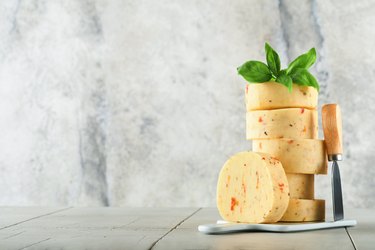
Firm cheeses: These include some familiar favorites, including cheddar, Gouda and Monterey Jack. They slice well, stack without sticking to each other and are stiff enough that you won't necessarily need bread or crackers to go with them.
Hard cheeses: These are the intensely flavored "grating cheeses" such as Parmigiano-Reggiano, Grana Padano, Pecorino Romano and Asiago. Set them out in thin curls, or just put a block on your board with a paring knife.
Blue cheeses: Blue cheeses range from mild and creamy to sharp and crumbly, which means it's easy to choose a blue that will complement everything else on your tray. Bear in mind that these categories are very general: An individual cheese can span several depending how (and how long) it has been aged. Gouda, for example, is mild and medium-firm when new, but gets sharper and dryer as it ages and ultimately becomes an interesting alternative to Parmesan or Asiago.
4. Breads & carbs

Many of the foods on your charcuterie board can be eaten alone, but they're often best enjoyed with bread as an accompaniment. "Bread" is used loosely here—it can refer to anything from actual breads (a crusty baguette, a dark rye, a soft white loaf) to crackers, flatbreads like pita or naan, breadsticks and crispbreads or even pretzels. Bread should essentially serve as a vessel for meat, cheese and accompaniments, but if they happen to bring some flavor or textural interest of their own, consider it a plus.
5. Fruit, nuts & vegetables
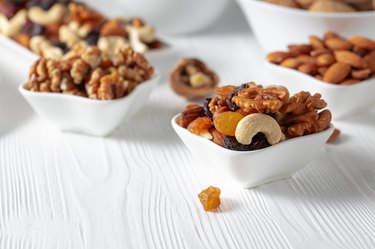
A charcuterie board is primarily about meats and cheeses, but the plant kingdom should also be well-represented. Fresh vegetables—cherry tomatoes, cucumbers, radishes, julienned carrots, strips of bell pepper—make excellent palate cleansers between bites of the richer, heavier stuff. So do fresh or dried fruits, which complement meats beautifully. Fresh fruit might include figs, blueberries or raspberries, cantaloupe or other melons and sliced apples and pears. Dried fruits could include cranberries, apricots, dates, figs (again) or even fruit leather.
Let's not forget preserved fruits and vegetables (and condiments made from them), which are also some of the tastiest things to include on your board. These range from artichoke hearts to olives to tiny, sour French-style pickles (cornichons) or spicy pickled asparagus. As for fruit, your favorite preserves and conserves are all appropriate choices. There are some specialty options in this category as well, such as the Spanish quince paste (mimbreno) that serves as a classic accompaniment to a full-flavored Manchego cheese.
Last but not least in this category: nuts. Most nuts work well on a charcuterie board, from walnut halves to almonds to pecans. Lightly toasting them ahead of time will improve their flavor and give them a crisper texture. You might also consider offering smoked or candied nuts.
6. Spreads, condiments & dips
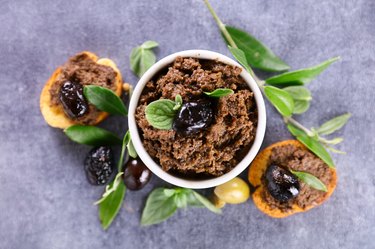
The final category of trappings for your charcuterie board is a broad one—and often underrated. It includes all other kinds of condiments, relishes, spreads and dips that lend a little extra "somethin' somethin'" to the board. This ranges from classics like hummus or your favorite spinach dip to an interesting chutney or two (often straddling the line between sweet and savory) to Euro-themed tapenade. Some of these can stand alone as appetizers—but as long as they complement the overall spread, they're great board additions.
Charcuterie 101: What in the World Is Tapenade?
Tapenade is a French spread made by pureeing black olives with capers and anchovies, among other ingredients.
Part 2: Perfect Pairings
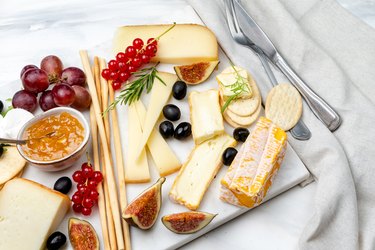
Charcuterie choices set the tone for the rest of your board because each includes a complementary accompaniment. Providing one or two of these alongside each corresponding charcuterie item anchors the board, leaving room to fill the spaces between with more general garnishes. It's typical to choose something with similar characteristics to complement each meat or with different flavors to create contrast.
A third option is to group foods with geographic connections on the widely quoted basis that "what grows together goes together." There's good justification for this, as a region's foods are usually fine-tuned to work nicely in tandem. You can't go wrong pairing Greek olives with loukanika sausage and feta cheese, for example, or Spanish chorizo with a good Manchego, some mimbreno and a bowl of Marcona almonds.
1. Pairings for prosciutto (plus other dry hams)
Prosciutto, Serrano ham and their equivalents have a salty funk that somehow manages to feel light and clean on your palate. For pairing purposes, lean into "light and clean" with fresh, mild cheeses. Burrata or fresh mozzarella are good choices, but a mild Brie would also hit the spot. Alternatively, lean into saltiness with a good Parmigiano-Reggiano or something similar. Because both are salty, your palate will "tune out" the salt and focus on the other nuances in their respective flavors.
As for fruit and other pairing options, a classic choice is prosciutto and melon—specifically cantaloupe. Don't be afraid to think outside the box, though. Papaya, fresh figs, well-ripened pears and even dragonfruit work equally well. Just don't wrap prosciutto around papaya ahead of time, as the fruit contains enzymes that will soften the meat.
2. Pairings for sausages
Sausages are the most variable meats on your board, so it's necessarily harder to make broad recommendations. Instead, we'll look separately at a few of the main flavor profiles.
3. Pairings for pork-forward salamis
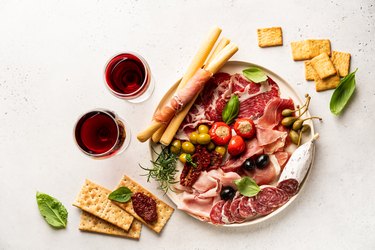
Pork-forward salamis have the cleanest flavor profile because they're un- or minimally spiced and rely on salt, pork and fermentation to create complexity. Think in terms of a classic French saucisson sec or a mild ("sweet") soppressatta. It's the type of salami closest to prosciutto in flavor profile, so the same types of cheese that work with prosciutto make good pairings here as well.
4. Pairings for garlic-forward salamis
This is the most common flavor profile, and it works well with several cheese types. Cheeses with creamy, buttery profiles (Havarti, young Gouda) are excellent choices. So are Alpine-style cheeses like Gruyère and Appenzeller, which bring an appealing nuttiness (and in the best examples, herbal and grassy notes).
5. Pairings for spice-forward sausages
This includes a range of peppery sausages, generating heat from either peppercorns or chilis. Examples include Calabrian salami, Spanish chorizo and good-quality pepperoni (not pizza-grade). One unusual example is 'nduja, which has a flavor profile not unlike a spicy salami but is spreadable. Pair these with creamy cheeses that will moderate the burn—or with an aged, medium-firm cheese that's got some tang of its own. (Manchego with chorizo is a classic pairing, for example.) Another option is a fluffy, tangy goat cheese, which complements the sausage with its own fresh-but-funky creaminess.
Sausages with spice combinations other than simple heat need to be treated on a case-by-case basis. Saucisson sec from France's Alsace region, for example, has what we'd think of as "warm" spices (like nutmeg and cloves). Nuts and dried fruit pair nicely with that one, or a nutty Alpine-style cheese. When in doubt, trust your own palate: Taste a sample of whichever sausage you'll be serving and try your accompaniments until you find a few winners.
6. Pairings for pâtés & meat pastes
Pâtés, rillettes, mousses and all of their variations make a fine addition to any board. Some pâtés are firm enough to be served in individual slices, but more often you'll set out a thick slice of pâté and let your guests cut their own portions. The same holds true for terrines and mousses. (Mousses are the finest-textured example of the style, while pâtés tend to be coarser.) Rillettes are served in small ramekins, so your guests will scoop and spread for themselves.
Because they're rich and smooth, pâtés benefit from tanginess to provide balance. Options include tart pickles (traditionally cornichons, but pickled onions or even marinated vegetables also work) and bright-flavored chutneys and relishes. Good-quality mustard is a fantastic condiment choice here. For cheese, lean into the richness with something creamy like a Camembert or take the opposite tack and choose a hard cheese like Asiago or Pecorino Romano. A textured country pâté works best with a soft cheese, while the hard cheese makes a nicely contrasting texture for a delicate mousse.
Part 3: Prepping & Planning
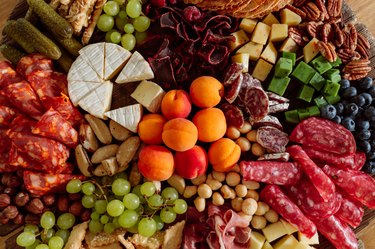
Take any combination of the ingredients we've discussed, drop them in handfuls on a board or serving platter and you'll have something you can call a charcuterie board. But a truly good charcuterie board is more than the sum of its parts. Knowing how to put those parts together is what will raise your board to a higher level (because who wants to settle for "just okay?").
There are a few broad principles to keep in mind as you start your planning:
1. Pay attention to quantities
For appetizer purposes, you'll need about 2 ounces of charcuterie per person in total and roughly the same amount of cheese. Ideally, you'll have enough bread to accompany every piece of meat and most of the cheese. If your charcuterie board will be served in lieu of a meal, double the quantity of meat and cheese. There's a bit of flex room involved: You can scale back if you'll have a lavish spread of extras such as fruit, veggies and dips, or allow extra if there won't be many add-ons.
2. Match the spread to your crowd
For the office party or a big family get-together, you're probably okay using supermarket ingredients and aiming for quantity over quality. For a smaller group with refined tastes, showcasing a relatively small handful of exceptional meats and cheeses is better.
3. Mix things up
Try to provide a nicely varied range of flavors, textures, curing methods and colors. Combinations of soft and firm, crunchy and chewy, smoky and sweet or pungent and creamy all provide more interest than lots of the same thing. For example, picking supermarket-grade brick, Jack and cheddar cheese is an uninspired choice because they're all similar in texture and flavor. A creamy Brie, a nutty Gruyere and a good Parmesan would be much more interesting without scaring anyone away.
4. Go for odd numbers
Meats are the centerpiece of your board. The overall spread will be more visually appealing if you select them in odd numbers (typically three or five choices, but up to seven is possible for a big spread). Each meat choice will anchor one section of your board with cheeses and other items clustered around. What if you've already chosen four kinds of charcuterie? Simply set out two piles of whichever you have most of. Now it's an odd number.
5. Take cheeses out ahead of time
Cheeses need at least 30 to 45 minutes out of refrigeration for their flavors to open up (rather like aerating wine), so don't leave them until the last minute. Set them out in their own packaging ahead of time while leaving space for them on your board. After they've come to room temperature, you can put the cheeses in position.
Part 4: Building the Board
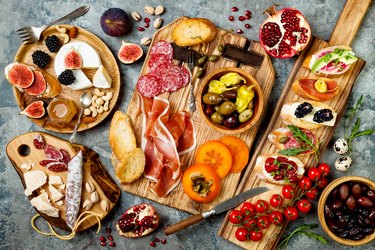
Once you've chosen your charcuterie items and a core handful of appropriate pairings to go alongside, it's time to finish assembling your board. Here's a suggested order of assembly that will work for most purposes.
1. Create sections & add meat
Place one of your charcuterie items in each section as the anchor (flexible offerings like prosciutto or cold-smoked salmon can be folded, or even turned into rosettes, to make them more attractive and easier to pick up). Alternatively, make a continuous, diagonally winding line (a "river") of one kind of meat across your board and arrange the others on either side.
2. Round it out
Set your choice of complementary cheese alongside each of the meats, leaving a bit of space in between. Add non-cheese accompaniments that are intended as a specific pairing (the fruit to go with your prosciutto, for example). At this point, the rough outline of your board will be complete (the spine, if you will) and it's time to have fun fleshing it out.
Scatter strips of yellow, orange, red and green bell pepper in small mounds around the board—or whichever colorful fruits and vegetables (carrot sticks, cherry tomatoes, jewel-like berries) you have at your disposal. Color adds major visual impact! Next, incorporate glossy green and black olives, pickles or colorful preserves and chutneys. Serving them in small white bowls or ramekins will make colors pop even more.
3. Mind the gaps
Reserve space for breads (which tend to be bulky) around the edges of the board or even on separate plates and cutting boards nearby. The exception would be any breads or crackers you intend to use as pairings for a specific meat, cheese or other element on the tray. Those should be placed close by. Arrange the smallest accompaniments—nuts or candied nuts, dried fruits—in small bowls or simply mound them directly onto the board wherever there's space.
Speaking of space, don't feel compelled to fill every square inch of the board. Leaving free space between foods is a "win" aesthetically, especially if you have a pretty serving board. It's better to create—and periodically refill—an attractive spread than to pile everything on at once.
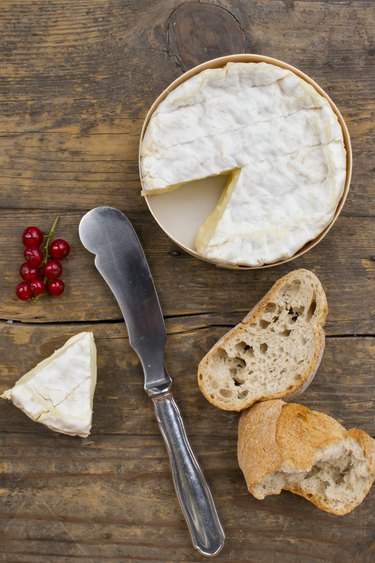
4. Arrange utensils
Finally, make sure you've got utensils covered. Each cheese, unless it's already sliced, requires a cheese knife or paring knife. Pâtés and soft cheeses call for a spreader. Meats need forks or tongs or, at the very least, a large supply of toothpicks. Condiments and chutneys require spoons.
The whole process sounds like a lot of work, but most of that effort boils down to planning selections. The actual prep time is surprisingly minimal (most meats come already sliced, for instance), so putting out your best charcuterie board ever will usually require less effort than a sit-down meal or even a spread of conventional appetizers. That means more time catching up with friends, sharing stories and even tuning in to a bit of harmless gossip—and isn't that what social gatherings are about?